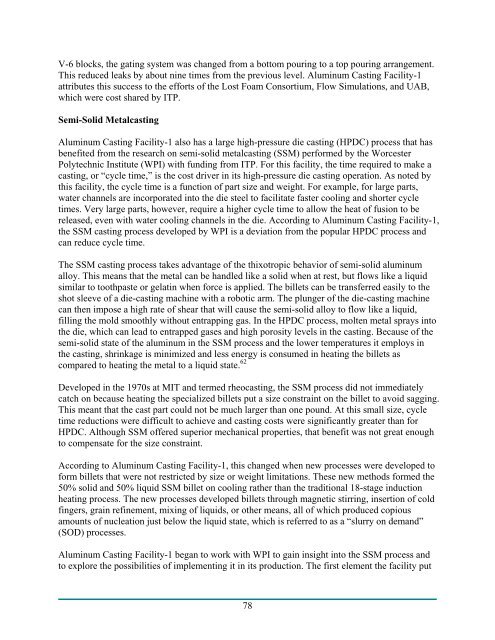Implementation of Metal Casting Best Practices - EERE - U.S. ...
Implementation of Metal Casting Best Practices - EERE - U.S. ...
Implementation of Metal Casting Best Practices - EERE - U.S. ...
Create successful ePaper yourself
Turn your PDF publications into a flip-book with our unique Google optimized e-Paper software.
V-6 blocks, the gating system was changed from a bottom pouring to a top pouring arrangement.<br />
This reduced leaks by about nine times from the previous level. Aluminum <strong>Casting</strong> Facility-1<br />
attributes this success to the efforts <strong>of</strong> the Lost Foam Consortium, Flow Simulations, and UAB,<br />
which were cost shared by ITP.<br />
Semi-Solid <strong>Metal</strong>casting<br />
Aluminum <strong>Casting</strong> Facility-1 also has a large high-pressure die casting (HPDC) process that has<br />
benefited from the research on semi-solid metalcasting (SSM) performed by the Worcester<br />
Polytechnic Institute (WPI) with funding from ITP. For this facility, the time required to make a<br />
casting, or “cycle time,” is the cost driver in its high-pressure die casting operation. As noted by<br />
this facility, the cycle time is a function <strong>of</strong> part size and weight. For example, for large parts,<br />
water channels are incorporated into the die steel to facilitate faster cooling and shorter cycle<br />
times. Very large parts, however, require a higher cycle time to allow the heat <strong>of</strong> fusion to be<br />
released, even with water cooling channels in the die. According to Aluminum <strong>Casting</strong> Facility-1,<br />
the SSM casting process developed by WPI is a deviation from the popular HPDC process and<br />
can reduce cycle time.<br />
The SSM casting process takes advantage <strong>of</strong> the thixotropic behavior <strong>of</strong> semi-solid aluminum<br />
alloy. This means that the metal can be handled like a solid when at rest, but flows like a liquid<br />
similar to toothpaste or gelatin when force is applied. The billets can be transferred easily to the<br />
shot sleeve <strong>of</strong> a die-casting machine with a robotic arm. The plunger <strong>of</strong> the die-casting machine<br />
can then impose a high rate <strong>of</strong> shear that will cause the semi-solid alloy to flow like a liquid,<br />
filling the mold smoothly without entrapping gas. In the HPDC process, molten metal sprays into<br />
the die, which can lead to entrapped gases and high porosity levels in the casting. Because <strong>of</strong> the<br />
semi-solid state <strong>of</strong> the aluminum in the SSM process and the lower temperatures it employs in<br />
the casting, shrinkage is minimized and less energy is consumed in heating the billets as<br />
compared to heating the metal to a liquid state. 62<br />
Developed in the 1970s at MIT and termed rheocasting, the SSM process did not immediately<br />
catch on because heating the specialized billets put a size constraint on the billet to avoid sagging.<br />
This meant that the cast part could not be much larger than one pound. At this small size, cycle<br />
time reductions were difficult to achieve and casting costs were significantly greater than for<br />
HPDC. Although SSM <strong>of</strong>fered superior mechanical properties, that benefit was not great enough<br />
to compensate for the size constraint.<br />
According to Aluminum <strong>Casting</strong> Facility-1, this changed when new processes were developed to<br />
form billets that were not restricted by size or weight limitations. These new methods formed the<br />
50% solid and 50% liquid SSM billet on cooling rather than the traditional 18-stage induction<br />
heating process. The new processes developed billets through magnetic stirring, insertion <strong>of</strong> cold<br />
fingers, grain refinement, mixing <strong>of</strong> liquids, or other means, all <strong>of</strong> which produced copious<br />
amounts <strong>of</strong> nucleation just below the liquid state, which is referred to as a “slurry on demand”<br />
(SOD) processes.<br />
Aluminum <strong>Casting</strong> Facility-1 began to work with WPI to gain insight into the SSM process and<br />
to explore the possibilities <strong>of</strong> implementing it in its production. The first element the facility put<br />
78

















